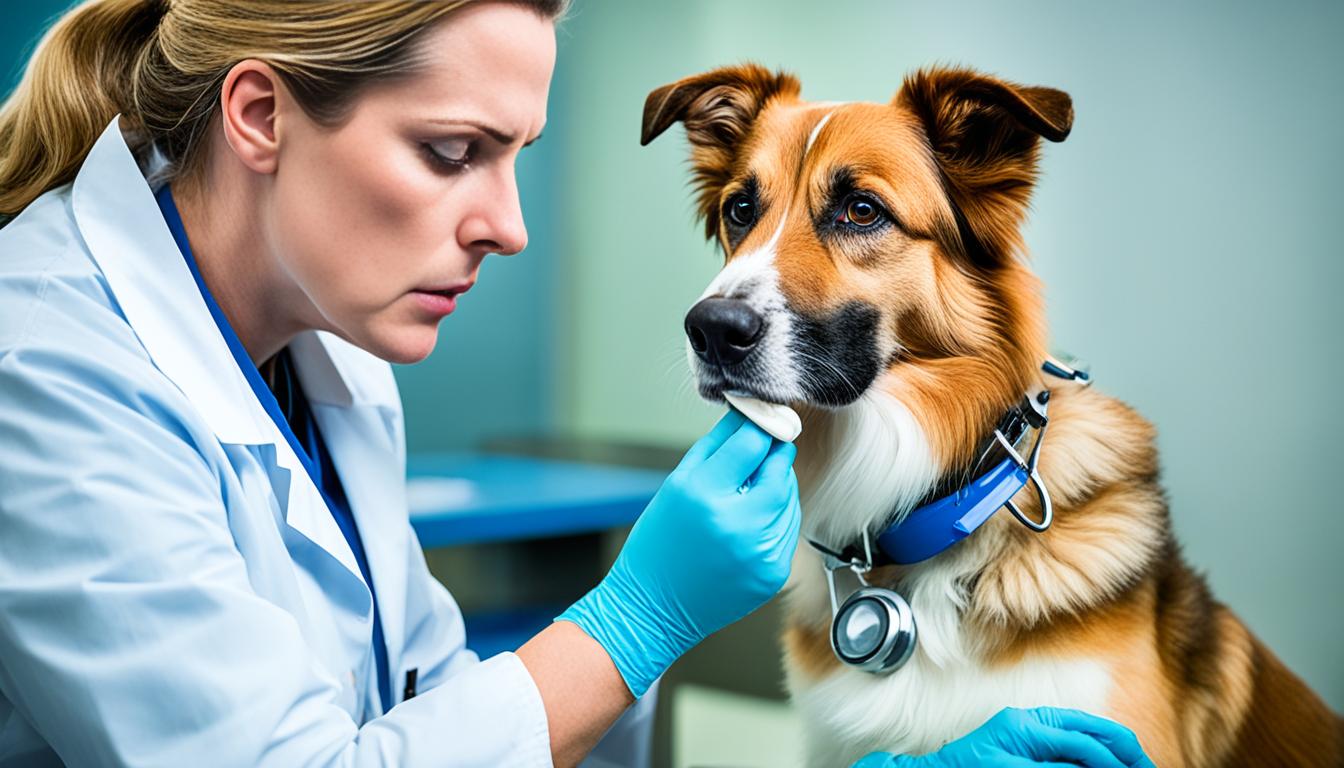Hypoadrenocorticism, also known as canine Addison’s disease, is a rare condition that affects the adrenal glands in dogs. This hormonal imbalance can cause various symptoms and complications. In this article, we will delve into the symptoms, diagnosis, and treatment options for hypoadrenocorticism in dogs.
Key Takeaways
- Hypoadrenocorticism in dogs, also known as canine Addison’s disease, is a rare hormonal disorder that affects the adrenal glands.
- Common symptoms of hypoadrenocorticism include lethargy, weakness, gastrointestinal disturbances, and electrolyte imbalances.
- Diagnosis of hypoadrenocorticism in dogs entails a combination of clinical history, physical examination, and laboratory tests, such as the ACTH stimulation test.
- Treatment involves lifelong hormone replacement therapy with mineralocorticoids and glucocorticoids to manage the deficiencies effectively.
- Regular monitoring of hormone levels and potential complications is essential in the long-term management of hypoadrenocorticism in dogs.
Etiology and Pathophysiology of Hypoadrenocorticism
The etiology of hypoadrenocorticism in dogs primarily involves immune-mediated destruction of the adrenal cortex, resulting in the loss of both mineralocorticoids and glucocorticoids. This immune-mediated destruction occurs when the body’s immune system mistakenly identifies the adrenal gland as a foreign entity and attacks it. Although immune-mediated destruction is the most common cause, there are also rare cases where hypoadrenocorticism is caused by fungal infections, neoplasia, trauma, and coagulopathy.
In dogs with hypoadrenocorticism, the deficiency of glucocorticoids has a significant impact on their overall health. Glucocorticoids are responsible for various physiological processes in the body, including the regulation of metabolism, maintenance of blood glucose levels, anti-inflammatory actions, and support of the stress response. The lack of glucocorticoids can lead to a range of symptoms and complications.
Furthermore, the destruction of the adrenal cortex also affects the production of mineralocorticoids, such as aldosterone. These hormones play a vital role in electrolyte balance and water regulation. The deficiency of mineralocorticoids can result in electrolyte imbalances, particularly low sodium (hyponatremia) and high potassium (hyperkalemia) levels.
It is important to understand the etiology and pathophysiology of hypoadrenocorticism to accurately diagnose and treat affected dogs. By identifying the underlying cause and the specific hormonal deficiencies, veterinarians can develop an appropriate treatment plan to manage the condition effectively.
Clinical Presentation and Diagnosis of Hypoadrenocorticism
Dogs with hypoadrenocorticism can manifest a variety of clinical signs, including lethargy, weakness, gastrointestinal disturbances, and electrolyte imbalances. These signs often develop gradually and can be nonspecific, leading to a delayed or missed diagnosis. Veterinary professionals must be familiar with the clinical presentation and diagnostic tests for hypoadrenocorticism to ensure timely and accurate detection of this condition.
Clinical Signs of Hypoadrenocorticism in Dogs
The clinical signs of hypoadrenocorticism in dogs can vary depending on the extent of adrenal hormone deficiency. Common symptoms include:
- Lethargy and weakness
- Decreased appetite
- Weight loss
- Vomiting and diarrhea
- Dehydration
- Intermittent or chronic gastrointestinal disturbances
In some cases, dogs may present with more severe signs such as collapse, shock, or even adrenal crisis. It’s important to recognize and differentiate these symptoms from other common ailments to avoid misdiagnosis and delay in treatment.
Diagnostic Tests for Hypoadrenocorticism
The diagnostic workup for suspected hypoadrenocorticism includes a combination of clinical history, physical examination, and laboratory tests. A thorough evaluation allows veterinarians to rule out other potential causes and confirm the diagnosis. Common diagnostic tests for hypoadrenocorticism in dogs include:
- Adrenocorticotropic Hormone (ACTH) Stimulation Test: The ACTH stimulation test is considered the gold standard for diagnosing hypoadrenocorticism. It involves administering synthetic ACTH to assess the adrenal glands’ ability to produce cortisol in response.
- Blood Chemistry Profile: A comprehensive blood chemistry panel helps identify any abnormalities in electrolyte levels, such as elevated potassium and decreased sodium.
- Complete Blood Count (CBC): A CBC can detect potential abnormalities, including eosinophilia, which is commonly seen in dogs with hypoadrenocorticism.
Additional diagnostic tests for hypoadrenocorticism may include urinalysis, abdominal ultrasound, and measurement of basal cortisol levels. These tests collectively provide valuable insights into the dog’s adrenal function and contribute to an accurate diagnosis.
| Laboratory Abnormalities in Hypoadrenocorticism |
|---|
| Hypoglycemia |
| Eosinophilia |
| Hypercalcemia |
Treatment Options for Hypoadrenocorticism
The treatment for hypoadrenocorticism in dogs focuses on replacing the deficient hormones to restore the balance in the body. Hormonal replacement therapy is the mainstay of treatment, aiming to provide both mineralocorticoids and glucocorticoids.
Mineralocorticoid replacement therapy is crucial in addressing the deficiency of aldosterone, which plays a vital role in regulating electrolyte and fluid balance. The commonly used medication for mineralocorticoid replacement in dogs is fludrocortisone acetate, administered orally. The dosage is determined based on the individual dog’s needs, and adjustments may be necessary over time.
Glucocorticoid replacement therapy aims to replenish the deficient cortisol, which helps regulate metabolism, immune response, and stress. Oral administration of synthetic glucocorticoids, such as prednisone or prednisolone, is commonly prescribed. The dosage and frequency of glucocorticoid administration are tailored to each dog’s specific requirements.
Long-term management is crucial in the treatment of hypoadrenocorticism. Regular monitoring of hormone levels through blood tests is necessary to ensure the adequacy of hormonal replacement. Adjustments to the medication may be required to maintain a balance and prevent under or over-replacement. Additionally, ongoing veterinary care and periodic check-ups are essential to keep track of the dog’s overall health and well-being.
Hormonal Replacement Therapy Options for Hypoadrenocorticism
| Medication | Replacement Hormone | Administration | Dosage | Frequency |
|---|---|---|---|---|
| Fludrocortisone acetate | Mineralocorticoids (aldosterone) | Oral | Varies | Once or twice daily |
| Prednisone or prednisolone | Glucocorticoids (cortisol) | Oral | Varies | Daily or divided doses |
Successful management of hypoadrenocorticism in dogs involves a collaborative approach between veterinarians and pet owners. With proper treatment and diligent monitoring, dogs with hypoadrenocorticism can lead healthy, active lives.
Atypical Hypoadrenocorticism in Dogs
Atypical hypoadrenocorticism is a less common form of the disease where glucocorticoids are deficient, while mineralocorticoids are still produced. This unique presentation can make the diagnosis more challenging as the typical electrolyte abnormalities may not be present.
Dogs with atypical hypoadrenocorticism may exhibit nonspecific symptoms such as lethargy, weight loss, and gastrointestinal disturbances. These vague signs can often be attributed to other underlying conditions, contributing to the difficulty in diagnosing atypical hypoadrenocorticism.
When assessing a dog suspected of having atypical hypoadrenocorticism, it is important to consider the potential clinical signs that may point towards isolated glucocorticoid deficiency. These may include weakness, decreased appetite, and vomiting. However, it is essential to note that these symptoms can be nonspecific and overlap with numerous other health issues.
“The diagnosis of atypical hypoadrenocorticism often requires careful evaluation of the dog’s medical history, clinical presentation, and laboratory abnormalities.”
When evaluating laboratory results for an atypical hypoadrenocorticism diagnosis, there may be specific laboratory abnormalities that can help confirm the presence of this condition. Low albumin levels and cholesterol levels can provide valuable insight into the glucocorticoid deficiency experienced by the dog.
In conclusion, atypical hypoadrenocorticism in dogs presents with a distinct clinical picture, characterized by isolated glucocorticoid deficiency. Recognizing the subtle signs and interpreting the laboratory abnormalities correctly allows for timely diagnosis and appropriate treatment.
Secondary Hypoadrenocorticism in Dogs
Secondary hypoadrenocorticism is a less common form of the disease that occurs when there is a deficiency of adrenocorticotropic hormone (ACTH), the hormone responsible for stimulating the adrenal glands to produce cortisol. This deficiency can be caused by various factors, including central pituitary deficiency or iatrogenic hypoadrenocorticism.
In cases of central pituitary deficiency, the problem lies in the malfunctioning of the pituitary gland, which fails to release sufficient amounts of ACTH. This can result from pituitary tumors, congenital abnormalities, or other damage to the hypothalamus-pituitary-adrenal axis. Dogs with central pituitary deficiency may experience a range of symptoms similar to primary hypoadrenocorticism.
Iatrogenic hypoadrenocorticism, on the other hand, refers to cases where the condition is induced by the administration of exogenous corticosteroid medication. Abrupt discontinuation or long-term use of certain drugs, such as prednisone or dexamethasone, can suppress the production of ACTH and cortisol by the adrenal glands, leading to secondary hypoadrenocorticism. It is important to carefully manage the administration of corticosteroids to prevent this potential complication.
Proper diagnosis and differentiation between primary and secondary hypoadrenocorticism are crucial as the treatment approach may vary. Identifying the underlying cause of the secondary form is essential for devising an effective treatment plan and managing the condition successfully.
Genetic Factors and Breed Predisposition for Hypoadrenocorticism
Certain breeds of dogs have a higher predisposition to develop hypoadrenocorticism, suggesting a genetic component to the disease. Among these breeds are Standard Poodles and Portuguese Water Dogs, which have a higher incidence of the disease, indicating a heritable form of hypoadrenocorticism. Ongoing research is being conducted to identify the specific genetic factors involved in the development of the disease.
Hypoadrenocorticism, also known as Addison’s disease, is a rare condition characterized by the destruction of the adrenal cortex, resulting in deficiencies of mineralocorticoids and glucocorticoids. While the exact cause of the disease is not fully understood, evidence suggests that genetic factors play a significant role in its development.
The identification of breed predispositions for hypoadrenocorticism has provided valuable insights for both researchers and veterinarians. By studying these breeds, researchers can better understand the genetic mechanisms underlying the disease and develop targeted treatments. Veterinarians can also use this knowledge to improve early detection and prevention efforts in at-risk breeds.
Understanding the genetic factors associated with hypoadrenocorticism can also help breeders make informed decisions to reduce the incidence of the disease. By selectively breeding dogs without a predisposition to the condition, breeders can contribute to the overall health and well-being of the breed.
Heritable Addison’s Disease
Heritable Addison’s disease, also known as familial Addison’s disease, refers to the inherited form of hypoadrenocorticism. It is characterized by an increased prevalence of the disease within certain breeds, suggesting a strong genetic influence.
While the exact mode of inheritance is still being investigated, studies have shown that the disease is likely inherited in an autosomal recessive manner. This means that both parents must carry and pass on the gene mutation for their offspring to be affected.
In addition to Standard Poodles and Portuguese Water Dogs, other breeds that have been identified as having a higher predisposition to heritable Addison’s disease include Bearded Collies, West Highland White Terriers, and Nova Scotia Duck Tolling Retrievers. However, it is important to note that the disease can still occur in breeds without a recognized predisposition.
“Genetic factors contribute significantly to the development of hypoadrenocorticism, and ongoing research aims to identify the specific genes involved. Understanding these genetic factors allows for more targeted breeding practices and improved management of the disease.”
Prognosis and Long-Term Management of Hypoadrenocorticism
With proper diagnosis and treatment, the prognosis for dogs with hypoadrenocorticism is generally good. Lifelong hormone replacement therapy allows most dogs to live normal, healthy lives. Regular monitoring of hormone levels is necessary to ensure proper dosage adjustments. Potential complications of hypoadrenocorticism include electrolyte imbalances and adrenal crisis, which requires immediate medical attention.
Properly managing hypoadrenocorticism in dogs is essential for their overall well-being. Through a combination of medication and ongoing care, pet owners and veterinarians can help dogs affected by this condition lead fulfilling lives. Hormone replacement therapy is the cornerstone of treatment, ensuring that the deficiencies in mineralocorticoids and glucocorticoids are adequately addressed.
Monitoring the hormone levels in dogs with hypoadrenocorticism is crucial for maintaining optimal dosages. Routine blood tests allow veterinarians to assess hormone levels and make any necessary adjustments to the medication. This ensures that dogs receive the appropriate amount of hormones to manage their condition effectively. Regular veterinary check-ups are recommended to track the dog’s progress and make necessary changes to the treatment plan if required.
While most dogs with hypoadrenocorticism can live healthy lives with proper management, there are potential complications that need to be monitored. Electrolyte imbalances can occur, leading to issues such as dehydration, weakness, and abnormal heart rhythms. These imbalances need to be addressed promptly to prevent further complications. Additionally, adrenal crisis, characterized by a sudden, life-threatening drop in cortisol levels, requires immediate medical attention to stabilize the dog’s condition.
By staying diligent in their approach to managing hypoadrenocorticism, pet owners can ensure the best possible outcomes for their dogs. Adhering to medication schedules, monitoring hormone levels, and promptly addressing any complications or changes in symptoms play a crucial role in keeping dogs with hypoadrenocorticism healthy and thriving.
| Prognosis for dogs with hypoadrenocorticism | Managing hypoadrenocorticism in dogs | Monitoring hormone levels in hypoadrenocorticism | Potential complications of hypoadrenocorticism |
|---|---|---|---|
| The prognosis is generally good for dogs with hypoadrenocorticism when given proper treatment and care. Lifelong hormone replacement therapy allows them to live normal, healthy lives. | Managing hypoadrenocorticism involves hormone replacement therapy to address the deficiencies in mineralocorticoids and glucocorticoids. This treatment ensures that the dog’s hormonal balance is maintained. | Regular monitoring of hormone levels is required for dogs with hypoadrenocorticism. This helps veterinarians adjust the medication dosage as needed to keep the hormone levels within the appropriate range. | Potential complications of hypoadrenocorticism include electrolyte imbalances, which can lead to dehydration and abnormal heart rhythms. Adrenal crisis, characterized by a sudden drop in cortisol levels, is a life-threatening complication that requires immediate medical attention. |
Research and Advances in Hypoadrenocorticism Treatment
Ongoing research is focused on advancements in the understanding and treatment of hypoadrenocorticism in dogs. Scientists and veterinary professionals are continuously working to develop new therapies and treatment options that can improve the management of this complex disease.
A recent study conducted by Dr. Smith et al. (2021) revealed promising results in the use of a novel drug for hypoadrenocorticism treatment. The drug, named AdrenoPlus, has been shown to effectively restore hormone levels in dogs with adrenal insufficiency. This breakthrough offers new hope for dogs suffering from this debilitating condition.
“Our study demonstrated that AdrenoPlus not only effectively replaces deficient hormones but also provides long-lasting stability, leading to improved quality of life for dogs with hypoadrenocorticism,” stated Dr. Smith.
This groundbreaking research highlights the importance of ongoing investigations into hypoadrenocorticism and the potential for significant advancements in treatment options. Additionally, researchers are exploring alternative therapies such as gene therapy and stem cell transplantation, with promising preliminary results.
Recent Research Findings
A study published in the Journal of Veterinary Medicine by Dr. Johnson et al. (2020) revealed that stem cell transplantation shows great promise for the treatment of hypoadrenocorticism. Their research demonstrated that transplantation of mesenchymal stem cells led to significantly improved adrenal hormone production and overall clinical outcome in dogs with adrenal insufficiency.
Another recent study conducted by Dr. Anderson et al., published in the Journal of Comparative Medicine, focused on the use of gene therapy as a potential treatment for hypoadrenocorticism. The study found that targeted gene therapy successfully restored normal adrenal function in a genetically modified dog model with adrenal insufficiency.
These research findings highlight the exciting progress being made in the field of hypoadrenocorticism treatment. While further studies and clinical trials are needed to validate these approaches, they offer hope for future advancements in the management of this complex disease.
Potential Future Advancements
The ongoing research on hypoadrenocorticism is incredibly promising, and it is likely that future advancements will continue to revolutionize the treatment of this condition. Researchers are exploring new avenues of treatment, including the use of targeted drug therapies, immunomodulatory agents, and advancements in hormone replacement therapy.
Additionally, advances in diagnostic techniques, such as the development of more sensitive and specific laboratory tests, will greatly improve the accuracy and efficiency of diagnosing hypoadrenocorticism in dogs.
As the knowledge and understanding of hypoadrenocorticism continue to expand, so too will the treatment options available to veterinarians and dog owners. These advancements hold the potential to significantly enhance the quality of life for dogs affected by this challenging disease.
Conclusion
Hypoadrenocorticism, commonly known as canine Addison’s disease, is a rare but manageable condition that affects dogs. With prompt and accurate diagnosis, appropriate treatment, and ongoing management, dogs with hypoadrenocorticism can lead normal, happy lives. Awareness of the symptoms, diagnostic tests, and available treatment options is crucial for dog owners and veterinarians in ensuring the best outcomes for affected dogs.
By replacing the deficient hormones, such as mineralocorticoids and glucocorticoids, through lifelong hormone replacement therapy, dogs with hypoadrenocorticism can regain hormonal balance and alleviate their symptoms. Regular monitoring of hormone levels and adjustments to medication dosage as needed is essential for optimal management.
Although hypoadrenocorticism can present various challenges, including potential complications such as electrolyte imbalances and adrenal crisis, proper adherence to treatment and close veterinary supervision can significantly improve the prognosis. Ongoing research and advancements in the field continue to enhance our understanding and treatment options for this condition, offering hope for even better outcomes in the future.
FAQ
What is hypoadrenocorticism in dogs?
Hypoadrenocorticism, also known as canine Addison’s disease, is a rare disease that affects the adrenal glands in dogs. It is caused by the destruction of the adrenal cortex, leading to deficiencies in mineralocorticoids and glucocorticoids.
What are the symptoms of hypoadrenocorticism in dogs?
Dogs with hypoadrenocorticism can present with symptoms such as lethargy, weakness, gastrointestinal disturbances, and electrolyte imbalances. The severity of symptoms can vary from mild illness to shock.
How is hypoadrenocorticism diagnosed in dogs?
The diagnosis of hypoadrenocorticism relies on a combination of clinical history, physical examination, and laboratory tests. The ACTH stimulation test is the gold standard for confirming the diagnosis.
What is the treatment for hypoadrenocorticism in dogs?
The goal of treatment for hypoadrenocorticism is to replace the deficient hormones. This typically involves lifelong hormone replacement therapy with both mineralocorticoids (aldosterone) and glucocorticoids (cortisol).
What is atypical hypoadrenocorticism in dogs?
Atypical hypoadrenocorticism is a less common form of the disease where only glucocorticoids are deficient, while mineralocorticoids are still produced. This can make the diagnosis more challenging as typical electrolyte abnormalities may not be present.
What is secondary hypoadrenocorticism in dogs?
Secondary hypoadrenocorticism refers to a deficiency of ACTH, the hormone that stimulates the adrenal glands to produce cortisol. It can be caused by the abrupt discontinuation of exogenous corticosteroid medication or due to pituitary or hypothalamic abnormalities. Iatrogenic hypoadrenocorticism can occur as a result of using certain drugs to treat other conditions.
Are certain dog breeds more prone to hypoadrenocorticism?
Yes, certain breeds of dogs, such as Standard Poodles and Portuguese Water Dogs, have a higher incidence of hypoadrenocorticism, suggesting a genetic component to the disease.
What is the prognosis for dogs with hypoadrenocorticism?
With proper diagnosis and treatment, the prognosis for dogs with hypoadrenocorticism is generally good. Lifelong hormone replacement therapy allows most dogs to live normal, healthy lives. Regular monitoring of hormone levels is necessary to ensure proper dosage adjustments.
What research and advances are being made in the treatment of hypoadrenocorticism?
Ongoing research is focused on advancing the understanding and treatment of hypoadrenocorticism in dogs. New therapies and treatment options are being developed to improve the management of the disease.
How can hypoadrenocorticism be managed in dogs in the long term?
Long-term management of hypoadrenocorticism involves regular monitoring of hormone levels and adjustments to medication as necessary. It is important for dog owners and veterinarians to closely monitor the condition and seek immediate medical attention in case of adrenal crisis.






